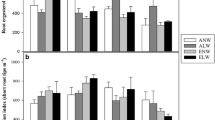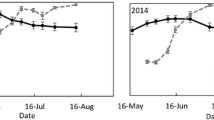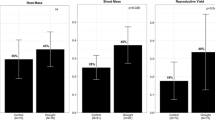Abstract
Climate warming can influence interactions between plants and associated organisms by altering levels of plant secondary metabolites. In contrast to studies of elevated temperature on aboveground phytochemistry, the consequences of warming on root chemistry have received little attention. Herein, we investigated the effects of elevated temperature, defoliation, and genotype on root biomass and phenolic compounds in trembling aspen (Populus tremuloides). We grew saplings of three aspen genotypes under ambient or elevated temperatures (+4–6 °C), and defoliated (by 75%) half of the trees in each treatment. After 4 months, we harvested roots and determined their condensed tannin and salicinoid (phenolic glycoside) concentrations. Defoliation reduced root biomass, with a slightly larger impact under elevated, relative to ambient, temperature. Elevated temperature decreased condensed tannin concentrations by 21–43% across the various treatment combinations. Warming alone did not alter salicinoid concentrations but eliminated a small negative impact of defoliation on those compounds. Graphical vector analysis suggests that effects of warming and defoliation on condensed tannins and salicinoids were predominantly due to reduced biosynthesis of these metabolites in roots, rather than to changes in root biomass. In general, genotypes did not differ in their responses to temperature or temperature by defoliation interactions. Collectively, our results suggest that future climate warming will alter root phytochemistry, and that effects will vary among different classes of secondary metabolites and be influenced by concurrent ecological interactions such as herbivory. Temperature- and herbivory-mediated changes in root chemistry have the potential to influence belowground trophic interactions and soil nutrient dynamics.





Similar content being viewed by others
References
Bale JS, Masters GJ, Hodkinson ID, Awmack CS, Bezemer TM, Brown VK, Butterfield J, Buse A, Coulson JC, Farrar J, Good JEG, Harrington R, Hartley SE, Jones TH, Lindroth RL, Press MC, Syrmnioudis I, Watt AD, Whittaker JB (2002) Herbivory in global climate change research: direct effects of rising temperature on insect herbivores. Glob Chang Biol 8:1–16
Barker HL, Holeski LM, Lindroth RL (2019) Independent and interactive effects of plant genotype and environment on plant traits and insect herbivore performance: a meta-analysis with Salicaceae. Funct Ecol 33:422–435
Chen H, Rygiewicz PT, Johnson MG, Harmon ME, Tian H, Tang JW (2008) Chemistry and long-term decomposition of roots of Douglas-fir grown under elevated atmospheric carbon dioxide and warming conditions. J Environ Qual 37:1327–1336
Cope OL, Lindroth RL (2018) Clonal saplings of trembling aspen do not coordinate defense induction. J Chem Ecol 44:1045–1050
Cope OL, Kruger EL, Rubert-Nason KF, Lindroth RL (2019) Chemical defense over decadal scales: ontogenetic allocation trajectories and consequences for fitness in a foundation tree species. Funct Ecol 33:2105–2115
Couture JJ, Meehan TD, Rubert-Nason KF, Lindroth RL (2017) Effects of elevated atmospheric carbon dioxide and tropospheric ozone on phytochemical composition of trembling aspen (Populus tremuloides) and paper birch (Betula papyrifera). J Chem Ecol 43:26–38
Dettlaff MA, Marshall V, Erbilgin N, Cahill JF Jr (2018) Root condensed tannins vary over time, but are unrelated to leaf tannins. AoB Plants 10:ply044
Deutsch CA, Tewksbury JJ, Tigchelaar M, Battisti DS, Merrill SC, Huey RB, Naylor RL (2018) Increase in crop losses to insect pests in a warming climate. Science 361:916–919
Donaldson JR, Lindroth RL (2008) Effects of variable phytochemistry and budbreak phenology on defoliation of aspen during a forest tent caterpillar outbreak. Agric and Forest Entomol 10:399–410
Hoegh-Guldberg O, Jacob D, Taylor M, Bindi M, Brown S, Camilloni I, Diedhiou A, Djalante R, Ebi K, Engelbrecht F, Guiot J, Hijioka Y, Mehrotra S, Payne A, Seneviratne SI, Thomas A, Warren R, Zhou G (2018) Impacts of 1.5°C global warming on natural and human systems. In: Masson-Delmotte V, Zhai P, Pörtner H-O, Roberts D, Skea J, Shukla PR, Pirani A, Moufouma-Okia W, Péan C, Pidcock R, Connors S, Matthews JBR, Chen Y, Zhou X, Gomis MI, Lonnoy E, Maycock T, Tignor M, and Waterfield T (eds) Global warming of 1.5°C. An IPCC Special Report on the impacts of global warming of 1.5°C above pre-industrial levels and related global greenhouse gas emission pathways, in the context of strengthening the global response to the threat of climate change, sustainable development, and efforts to eradicate poverty. World Meteorological Organization, Geneva
Holopainen JK, Virjamo V, Ghimire RP, Blande JD, Julkunen-Tiitto R, Kivimaenpaa M (2018) Climate change effects on secondary compounds of forest trees in the northern hemisphere. Front Plant Sci 9:1445
Huang W, Bont Z, Hervé MR, Robert CAM, Erb M (2020) Impact of seasonal and temperature-dependent variation in root defense metabolites on herbivore preference in Taraxacum officinale. J Chem Ecol 46:63–75
Jamieson MA, Trowbridge AM, Raffa KF, Lindroth RL (2012) Consequences of climate warming and altered precipitation patterns for plant-insect and multitrophic interactions. Plant Physiol 160:1719–1727
Jamieson MA, Schwartzberg EG, Raffa KF, Reich PB, Lindroth RL (2015) Experimental climate warming alters aspen and birch phytochemistry and performance traits for an outbreak insect herbivore. Glob Change Biol 21:2698–2710
Karssemeijer PN, Reichelt M, Gershenzon J, van Loon J, Dicke M (2020) Foliar herbivory by caterpillars and aphids differentially affects phytohormonal signalling in roots and plant defence to a root herbivore. Plant Cell Environ 43:775–786
Kling GW, Hayhoe K, Johnson LB, Magnuson JJ, Polasky S, Robinson SK, Shuter BJ, Wander MM, Wuebbles DJ, Zak DR, Lindroth RL, Moser SC, Wilson ML (2003) Confronting climate change in the Great Lakes region: impacts on our communities and ecosystems. Union of Concerned Scientists, Cambridge, MA, and Ecological Society of America, Washington, DC
Koricheva J (1999) Interpreting phenotypic variation in plant allelochemistry: problems with the use of concentrations. Oecologia 119:467–473
Lama AD, Kim J, Martiskainen O, Klemola T, Salminen JP, Tyystjärvi E, Niemelä P, Vuorisalo T (2016) Impacts of simulated drought stress and artificial damage on concentrations of flavonoids in Jatropha curcas (L.), a biofuel shrub. J Plant Res 129:1141–1150
Lemoine NP, Doublet D, Salminen J-P, Burkepile DE, Parker JD (2017) Responses of plant phenology, growth, defense, and reproduction to interactive effects of warming and insect herbivory. Ecology 98:1817–1828
Li Y, Sun D, Li D, Xu Z, Zhao C, Lin H, Liu Q (2015) Effects of warming on ectomycorrhizal colonization and nitrogen nutrition of Picea asperata seedlings grown in two contrasting forest ecosystems. Sci Rep 5:17546
Li Z, Yang J, Shang B, Xu Y, Couture JJ, Yuan X, Kobayashi K, Feng Z (2020) Water stress rather than N addition mitigates impacts of elevated O3 on foliar chemical profiles in poplar saplings. Sci Total Environ 707:135935
Lindroth RL, St. Clair SB (2013) Adaptations of quaking aspen (Populus tremuloides Michx.) for defense against herbivores. For Ecol Manag 299:14–21
Madritch M, Donaldson JR, Lindroth RL (2006) Genetic identity of Populus tremuloides litter influences decomposition and nutrient release in a mixed forest stand. Ecosystems 9:528–537
Mikkelsen BL, Olsen CE, Lyngkjar MF (2015) Accumulation of secondary metabolites in healthy and diseased barley, grown under future climate levels of CO2, ozone and temperature. Photochemistry 118:162–173
Mundim FM, Alborn HT, Vieira-Neto EHM, Bruna EM (2017) A whole-plant perspective reveals unexpected impacts of above- and belowground herbivores on plant growth and defense. Ecology 98:70–78
Porter LJ, Hrstich LN, Chan BG (1986) The conversion of procyanidins and prodelphinidins to cyanidin and delphinidin. Phytochemistry 25:223–230
Rasmann S, Agrawal AA (2008) In defense of roots: a research agenda for studying plant resistance to belowground herbivory. Plant Physiol 146:875–880
Rubert-Nason KF, Lindroth RL (2019) Analysis of condensed tannins in Populus spp. using reversed phase UPLC-PDA-(−)esi-MS following thiolytic depolymerisation. Phytochem Anal 30:257–267
Rubert-Nason KF, Lindroth RL (2021). Causes and concequences of condensed tannin variation in Populus: a molecules to ecosystems perspective. In: Recent advances in polyphenol research, volume 7. In Press
Rubert-Nason KF, Keefover-Ring KK, Lindroth RL (2018) Purification and analysis of salicinoids. Curr Anal Chem 14:423–429
Salazar A, Rousk K, Jonsdottir IS, Bellenger JP, Andresson QS (2020) Faster nitrogen cycling and more fungal and root biomass in cold ecosystems under experimental warming: a meta-analysis. Ecology 101:e02938
Schweitzer JA, Bailey JK, Rehill BJ, Martinsen GD, Hart SC, Lindroth RL, Keim P, Whitham TG (2004) Genetically based trait in a dominant tree affects ecosystem processes. Ecol Lett 7:127–134
Sellmer JC, McCown BH, Haissig BE (1989) Shoot culture dynamics of six Populus clones. Tree Physiol 5:219–227
Sobuj N, Virjamo V, Zhang Y, Nybakken L, Julkunen-Tiitto R (2018) Impacts of elevated temperature and CO2 concentration on growth and phenolics in the sexually dimorphic Populus tremula (L.). Environ Exp Bot 146:34–44
Stevens MT, Gusse AC, Lindroth RL (2014) Root chemistry in Populus tremuloides: effects of soil nutrients, defoliation, and genotype. J Chem Ecol 40:31–38
Suseela V, Tharayil N, Pendall E, Rao AM, Volder A (2017) Warming and elevated CO2 alter the suberin chemistry in roots of photosynthetically divergent grass species. AoB Plants 9:plx041
Tsunoda T, van Dam NM (2017) Root chemical traits and their roles in belowground biotic interactions. Pedobiologia 65:58–67
Wuebbles DJ, Hayhoe K (2004) Climate change projections for the United States Midwest. Mitig Adapt Strateg Glob Chang 9:335–363
Zadworny M, McCormack ML, Żytkowiak R et al (2017) Patterns of structural and defense investments in fine roots of scots pine (Pinus sylvestris L.) across a strong temperature and latitudinal gradient in Europe. Glob Chang Biol 23:1218–1231
Zhou Y, Tang J, Melillo JM, Butler S, Mohan JE (2011) Root standing crop and chemistry after six years of soil warming in a temperate forest. Tree Physiol 31:707–717
Acknowledgments
We thank Michael Falk (Wisconsin Department of Agriculture, Trade, and Consumer Protection) for laboratory assistance and Hilary L. Barker (Wisconsin Technical College System) for advice regarding statistical analyses. We also thank Ann Hagerman and three anonymous reviewers for comments that improved the manuscript.
Funding
This work was funded by the University of Wisconsin-Madison, the United States Department of Agriculture (NIFA AFRI grant no. 2011–67,013-30,147) and the Chinese Scholarship Council (File No. 201406390041 to Z.L.).
Author information
Authors and Affiliations
Corresponding author
Ethics declarations
Conflict of Interest
The authors declare that they have no conflict of interest.
Electronic Supplementary Material
ESM 1
(DOCX 246 kb)
Rights and permissions
About this article
Cite this article
Li, Z., Rubert-Nason, K.F., Jamieson, M.A. et al. Root Secondary Metabolites in Populus tremuloides: Effects of Simulated Climate Warming, Defoliation, and Genotype. J Chem Ecol 47, 313–321 (2021). https://doi.org/10.1007/s10886-021-01259-w
Received:
Revised:
Accepted:
Published:
Issue Date:
DOI: https://doi.org/10.1007/s10886-021-01259-w




